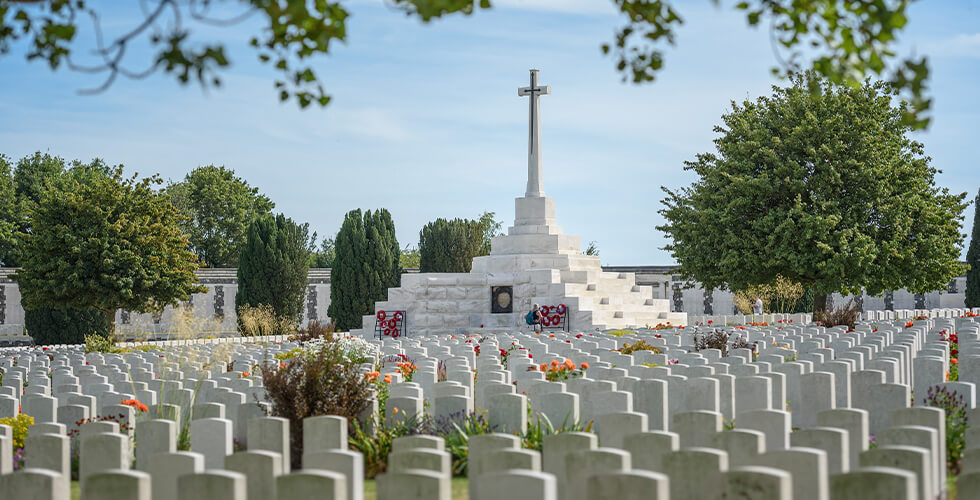01 November 2019
The Stories of Mazargues War Cemetery
Mazargues War Cemetery, in France, is one of the Commission’s most beautiful cemeteries but as Communication and Events Assistant, Lucie Balin, has discovered, it also plays host to stories that have their roots across the globe.

Throughout its history, Marseilles was the crossing point between mainland France and the Mediterranean Sea. Founded by Greek settlers as early as 600 BC, the port city is the first stop as you leave France and is the first land you’ll step on when you arrive.
Today, Marseilles remains one of France’s busiest cities. Each day, masses of freight flow into the city, cruise ships dock spilling tourists onto the streets and the local fishing fleet goes about its task of feeding a nation. But nestled within the hustle and bustle of this modern city lies a physical reminder of Marseilles’ global past.
When you step from the streets of Marseille into Mazargues War Cemetery, you cannot help but relax a little. Moving from the hubbub of a working city into the tranquillity that surrounds all CWGC sites, you can take a moment to pause, to smell the lavender growing around the Stone of Remembrance and listen to the water that runs throughout the cemetery.

Creating Mazargues War Cemetery and ensuring it met the Commission’s high standards was a technical challenge that required a creative solution. The Mediterranean climate means that often there is not enough natural water to ensure the same levels of greenery that you will see at war cemeteries such as Tyne Cot and Bayeux, and the rain that does fall is often not retained by the soil, which consists largely of sand and gravel. Therefore, a unique irrigation system was required.
Water flows through the cemetery in a system of shallow stone trenches fed by reservoir pools, ensuring even distribution throughout the grounds. Where once trenches invoked death and destruction, in Mazargues they mean life and growth.
The cemetery itself lies far from the main French battlefields, but during the First World War, Marseilles was the central point of arrival and departure for millions of soldiers, both French colonial troops from Africa and Commonwealth forces.
Throughout the war the Royal Navy, Merchant Navy, British troops and labour units (including Egyptian and Chinese Labour Corps) also worked in the port or passed through. Across the whole area, camps sheltered refugees, labour forces, war prisoners and transitioning troops. Bases and hospital facilities were established around the outskirts of the city.

Troops at Marseilles during First World War, Senegalese men in Pharo & Bengal Lancers parade in Marseilles
As a result, Mazargues War Cemetery reflects the diversity of the nationalities that passed through during the two world wars.
Amongst the casualties commemorated, almost a thousand were soldiers or labourers from India. The Indian expeditionary forces fought across France as well as East Africa, Mesopotamia, Egypt and Gallipoli. Mazargues War Cemetery is the second largest site where Indian men are commemorated after Neuve-Chapelle War Memorial in northern France.
The cemetery also contains a memorial, unveiled by Field Marshal Sir William Birdwood in 1925 and located at the rear of the cemetery, commemorating 205 Indian casualties who were cremated during the war and buried temporarily in St. Pierre cemetery.
At the time, cremation was illegal under French law. Dispensation was granted by the French authorities and special arrangements were made to carry out the cremation of Hindu and Sikh servicemen, and a ‘Ghat’ - cremation site - was established near the coast.
After the war, the bodies and ashes of the servicemen who died at Marseilles and who were originally buried in four of the city cemeteries, were brought together at the cemetery in Mazargues.

Labourers from China, Egypt, Fiji and the British West Indies are also commemorated in the cemetery. A stone tablet on the left-hand wall of the cemetery also honours several members of the Egyptian Labour Corps who were buried in Le Canet New Communal, Marseilles.
Maciu Natogo, from the Fijian Labour Corps, died on the 22 June 1918. The inscription on his grave says “Who was buried in St. Pierre Cemetery, Marseilles but whose grave is now lost. Their glory shall not be blotted out.”
Mazargues War Cemetery is also the resting place of 267 Second World War casualties, including 26 who died in an air crash on 15 January 1946.
British Soldiers, who had been freed from Japanese internment camps, were being flown home via Marseilles. Unfortunately, their Dakota transport plane crashed while flying over the Marseilleveyre mountain range during a winter snowstorm. There were only two survivors. The epitaph of Warrant Officer John Wyvill Suart, the flight’s navigator, states: “There are no accidents with God.”
To me, Mazargues War Cemetery is one of the most striking examples of how the World Wars touched so many nations around the world. Stood in the cemetery today, you can see the headstones of men from all four corners of the globe. Men who in peace time would never have stepped foot on the same continent, but who were drawn together by war and who are now remembered in this oasis of calm, in a small corner of a foreign city, far from home.


